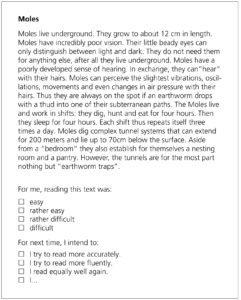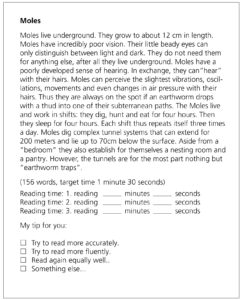Procedure:
Prior to the training period of several weeks, the instructor informs the students about the goal and purpose of this training. S/he may certainly want to suggest at the same time that reading training in the first language also benefits reading in regular classroom instruction. In this introductory phase, experiences and techniques should be identified which students may already be aware of from their regular classes.
Suggestions about the concrete implementation:
- It is important to give students precise instructions prior to the exercises so that they are able to conduct the training as independently as possible. This affords the instructor time to observe individual students more closely, and to accompany and advise them.
- Concentrated listening in this part of training is equally important as good reading. Concentrated listening should also be explained to the students and practiced prior to the training (someone reads out loud and the others mark the reading mistakes).
- Reading fluency is practiced in tandem. Tandems are comprised of two students of the same level and age group. The difference in reading competences between them should not be too great.
- Attention is paid to accuracy of reading and reading speed. For this purpose, a stop watch may also be used (for target times, see below).
- Depending on the age of the students and the intensity of the training, the focus on specific aspects and potential mistakes will be determined:
- Reading flow (stagnations)
- Reading accuracy (slips of the tongue, omissions, misread words, etc.).
- Reading clarity (swalloing syllables, appropriate volume, etc.)
- Reading expression (monotonous reading, droning, etc.)
- Each tandem now receives one text, once as a reading sheet,once as a control sheet (see examples on the following pages). Texts will have to be prepared for different proficiency levels to allow for appropriate training opportunities for all age and proficiency levels. Tandem members agree who reads first (s1) and who listens (s2)
- S1 reads the text out loud for the first time and answers the questions at the bottom of the sheet (evaluation of difficulty “for next time, I intend to”). S2 clocks the time which s1 took to read the text, records it in the control sheet, and provides feedback (“My tip for you”).
- S1 reads the text a second time and then a third time. Each round includes self-evaluation and feedback, measuring and recording time, as decribed above.
- Role reversal; now s2 reads the same text (or a different text from the same proficiency level) three times, s1 measures the time and provides feedback.
- The control sheets are collected. This kind of regular recordings by the listeners provide sort of a read -out diary, which documents progress.
- Periodically there should be a short class discussion: what kinds of progress have you achieved, what have you noticed, etc.
Remarks:
- Under no circumstances should the purpose of training be sort of a contest to see who reads the texts as fast as possible. For this purpose, age-appropriate and level-specific target times are provided. For beginning readers, these should be about 65 words per minute; for more advanced students about 100 words per minute, and for accomplished readers about 130 words per minute.
- About text length: the texts should be readable in about 90 seconds. This translates into approximately 100 words for level 1, approx. 150 words for level 2, and about 200 words for level 3.
- Every reading and control sheet must contain the questions about self-assessment and measuring time, respectively, as well as “my tip for you”, as seen in the examples on the following page.
- In terms of efficiency and sustainability, it would be optimal if the training in reading fluency in HLT could be coordinated with regular classroom instruction (or at least with a few regular classroom teachers). It is certainly well worth finding out from regular teachers and their language teaching materials what kinds of applicable examples and exercises the students already know from their regular classes.
- It is useful to record the readings from time to time on a recording device. In the course of the training program there emerges sort of a read-out biography: the readers can listen to their progress by way of the sequential recordings, as well as see it from the declining number of recorded error markings in the protocols.
Sample reading sheet (middle level, 156 words)


Sample control sheet







